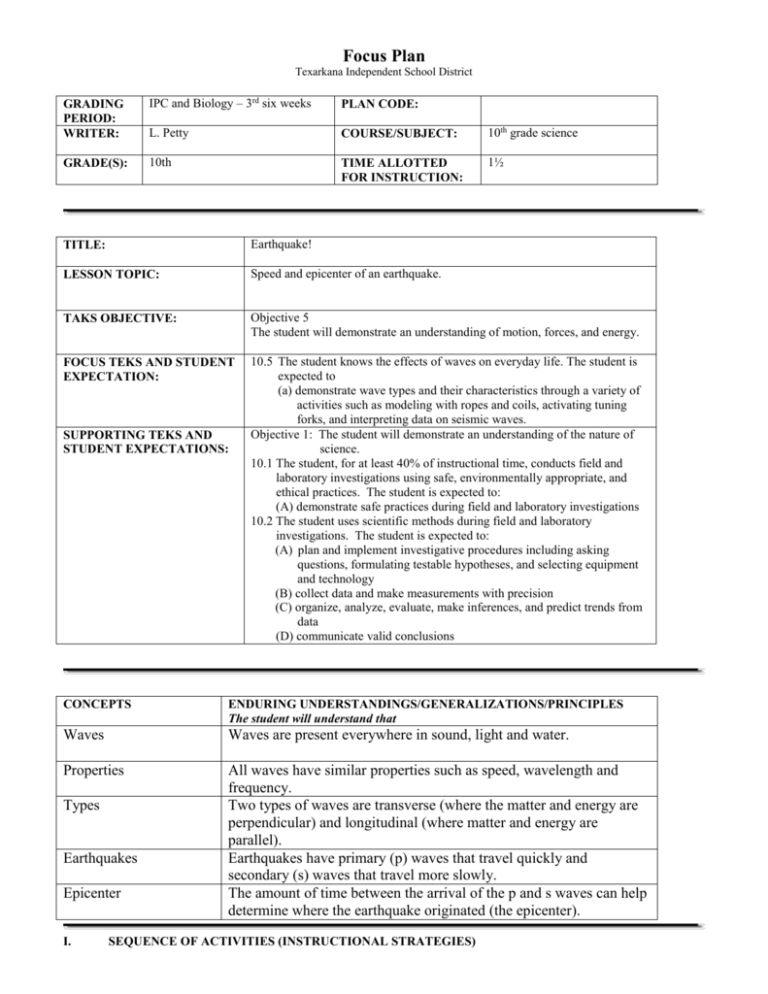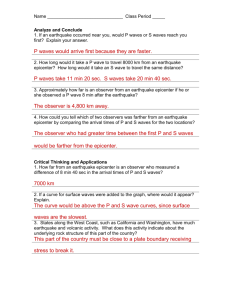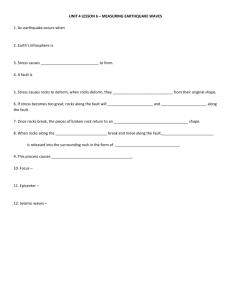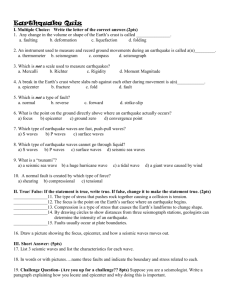10.5A Earthquake - Texarkana Independent School District
advertisement

Focus Plan Texarkana Independent School District GRADING PERIOD: WRITER: IPC and Biology – 3rd six weeks PLAN CODE: L. Petty COURSE/SUBJECT: 10th grade science GRADE(S): 10th TIME ALLOTTED FOR INSTRUCTION: 1½ TITLE: Earthquake! LESSON TOPIC: Speed and epicenter of an earthquake. TAKS OBJECTIVE: Objective 5 The student will demonstrate an understanding of motion, forces, and energy. FOCUS TEKS AND STUDENT EXPECTATION: 10.5 The student knows the effects of waves on everyday life. The student is expected to (a) demonstrate wave types and their characteristics through a variety of activities such as modeling with ropes and coils, activating tuning forks, and interpreting data on seismic waves. Objective 1: The student will demonstrate an understanding of the nature of science. 10.1 The student, for at least 40% of instructional time, conducts field and laboratory investigations using safe, environmentally appropriate, and ethical practices. The student is expected to: (A) demonstrate safe practices during field and laboratory investigations 10.2 The student uses scientific methods during field and laboratory investigations. The student is expected to: (A) plan and implement investigative procedures including asking questions, formulating testable hypotheses, and selecting equipment and technology (B) collect data and make measurements with precision (C) organize, analyze, evaluate, make inferences, and predict trends from data (D) communicate valid conclusions SUPPORTING TEKS AND STUDENT EXPECTATIONS: CONCEPTS ENDURING UNDERSTANDINGS/GENERALIZATIONS/PRINCIPLES The student will understand that Waves Waves are present everywhere in sound, light and water. Properties All waves have similar properties such as speed, wavelength and frequency. Two types of waves are transverse (where the matter and energy are perpendicular) and longitudinal (where matter and energy are parallel). Earthquakes have primary (p) waves that travel quickly and secondary (s) waves that travel more slowly. The amount of time between the arrival of the p and s waves can help determine where the earthquake originated (the epicenter). Types Earthquakes Epicenter I. SEQUENCE OF ACTIVITIES (INSTRUCTIONAL STRATEGIES) A. Focus/connections/anticipatory set Once students are seated, show a short clip from any earthquake video that shows the arrival of the p and s waves. Explain that the difference in arrival times (due to the different velocities of the two types of waves) can be used to locate the epicenter of the earthquake. B. Instructional activities (demonstrations, lectures, examples, hands-on experiences, role play, active learning experience, art, music, modeling, discussion, reading, listening, viewing, etc.) Complete Activity – Investigating the Speed of Earthquake Waves (1987 Prentice-Hall Laboratory Manual). C. Guided activity or strategy Model for students how to use a compass to draw circles around a spot using a scale. Use the Transparency Master – Using the Compass. D. Accommodations/modifications Students requiring accommodations should be assigned a peer tutor. E. Enrichment Students requiring enrichment may serve as peer tutors. II. STUDENT PERFORMANCE A. Description Complete Lab Worksheet – Earthquake! B. Accommodations/modifications Students requiring accommodations may be assigned a peer tutor. C. Enrichment Students requiring accommodations may serve as a peer tutor. III. ASSESSMENT OF ACTIVITIES A. Description Activity – Investigating the Speed of Earthquake Waves can be taken as either a daily or lab grade, or may not be taken as a grade. Lab – Earthquake! should be taken as a lab grade. B. Rubrics/grading criteria If the Activity is graded, the graph should count as 20 points, with 1 point given per graph point. The questions should could as 10 points each (60) and the last 20 points should be participation. Lab – Earthquake! should receive 2 points each for the data table sections. Five points should be given for each circle on Figure 2 with 5 additional points given for identifying the location of the epicenter. Questions should be graded as 4 points apiece. The last 26 points should be participation. C. Accommodations/modifications Students requiring accommodations may need help on Figure 2 in the lab but the questions should not require any additional help. On the Activity – students may need help with the graphing exercise. D. Enrichment Students requiring enrichment may be assigned as a peer tutor for the graphing and epicenter identification steps. E. Sample discussion questions 1. What is an epicenter? The point on the land surface directly above the focus is known as the epicenter. 2. What property of waves allows you to determine the epicenter? The speed of the wave. 3. Which wave travels faster? The P wave travels faster. 4. How can you determine your distance from the epicenter. Check the difference in time between the arrival of the P and S waves. 5. If you are closer to the earthquake, would the time between the arrival of the P and S waves be greater or less? less IV. TAKS PREPARATION A. Transition to TAKS context 1. Hal is exploring the properties of light. He reads in his textbook that light waves are refracted (bent) when they are transmitted from one substance to another. Hal also reads that the amount of refraction depends on the speed of the light waves. The greater the speed, the greater the refraction when light passes through different substances. Hal uses a prism to refract visible light into its component colors. Examine the drawing showing the outcome of Hal’s experiment. What can Hal deduce about the speed of the light waves as they separate when passed through a prism? (a) Violet light waves travel the fastest of all visible colors. (b) Red light waves travel the fastest of all visible colors. (c) Blue light waves travel the slowest of all visible colors. (d) Orange light waves travel the fastest of all visible colors. 2. Elizabeth wants to hear her stereo while she is in another room. She notices that she can hear the sound clearly if she points the speakers toward a wall. Study the diagram of the sound waves illustrated below. What property of waves does Elizabeth use to hear her stereo when she is in another room? (a) diffraction (b) reflection (c) absorption (d) refraction 3. A student drops her pencil into a glass of water that is two-thirds full. As she looks at the pencil through the glass, it appears to be bent at an angle where the pencil enters the water. The student knows that the pencil is not really bent. She places another pencil in an empty glass. That pencil does not appear to be bent. What causes the pencil to appear bent where it enters the water? (a) Light waves are absorbed by the water. The absorbed waves cause the pencil to appear bent. (b) Light waves are transmitted by the pencil. The transmitted waves cause the pencil to appear bent. (c) Light waves are refracted by the water. The waves change speed as they move from air to water. The change in the speed of the light waves causes the pencil to appear bent. (d) Light waves are reflected by the water. The reflected light waves cause the pencil to appear bent. B. Sample TAKS questions Spring 2003 1. At 0oC sound travels through air at a speed of 330 m/s. If a sound wave is produced with a wavelength of 0.10 m, what is the wave’s frequency? (a) 0.003 Hz (b) 33 Hz (c) 330 Hz (d) 3300 Hz 2. Which illustration best demonstrates compression waves? 3. At 0oC sound travels through air at a speed of 330 m/s. If a sound wav is produced with a wavelength of 0.10 m, what is the wave’s frequency? (a) 0.0033 Hz (b) 33 Hz (c) 330 Hz (d) 3300 Hz V. KEY VOCABULARY compass epicenter P wave VI. S wave velocity RESOURCES A. Textbook None needed B. Supplementary materials/equipment Activity – Investigating the Speed of Earthquake Waves Instructor’s Copy – Investigating the Speed of Earthquake Waves Transparency Master – Using the Compass Lab Instructions – Earthquake! Lab Worksheet – Earthquake! Instructor’s Copy – Earthquake! C. VII. Technology FOLLOW UP ACTIVITIES (reteaching, cross-curricular support, technology activities, next lesson in sequence, etc.) A. Reteach Go over students graded labs. B. Next lesson in sequence IPC & Biology – 5B Demonstrate wave interactions including interference, polarization, reflection, refraction, and resonance within various materials. VIII. TEACHER NOTES Before lab: 1. Make Transparency Master – Locating an Epicenter 2. Run a lab set of Lab Instructions (30-35). 3. Run a copy of Activity – Investigating the Speed of Earthquake Waves and Lab Worksheet – Earthquake! for each student. 4. Make sure you have enough compasses for at least every 2 students (1 for each student is ideal). During lab: 5. Make sure students know how to read the graph and draw circles with the compass.







